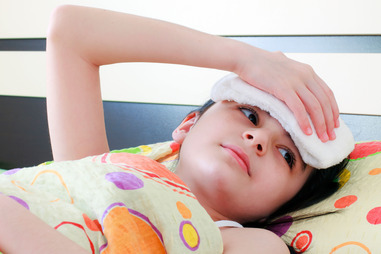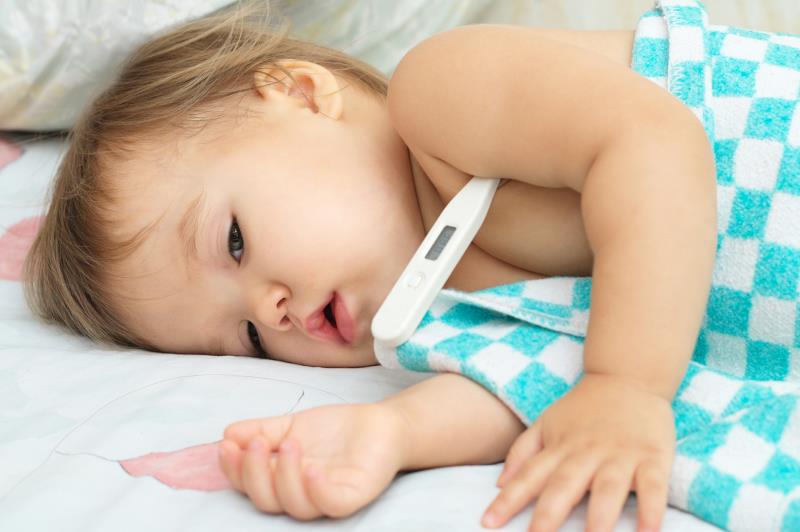One of parents' biggest worries is their children being sick with a fever. If allowed to get too high, the fever alone can cause health problems such as seizures. However, fever is generally harmless; it is the product of the body fighting off minor infections. Before starting a home remedy, you should check to make sure it is safe. It is important to know when to seek emergency help.

How to Break a Baby's Fever
1. Apply Cold Compress

If you notice your baby is feeling warmer, you can apply a cool, wet cloth to the forehead. The water from the cloth will evaporate from skin, drawing the fever out and bringing temperature down. Follow the steps:
- Fill a bowl with cool water.
- Soak a clean cloth and wring out extra water.
- Place cloth on your baby’s forehead, hands, feet and groin will also help reduce the fever.
- When the cloth is warm, place back in bowl and repeat.
- Repeat until fever breaks.
It’s important to not use ice cold or very cold water as this can instead cause a temperature spike.
2. Submerge in Lukewarm Bath
Placing your baby in a bath that isn’t hot or cold, but just lukewarm can help to relax him/her and regulate the body temperature. It can also help your baby sleep better, which will in turn provide a faster recovery.
You can do this a few times a day with a sponge for babies under 6 months or in the tub for those who are older. Make sure to dress your baby immediately after the bath so he/she doesn’t catch a chill.
3. Nurse More Frequently

To learn how to break a baby's fever, give your baby as much breast milk as possible if you are nursing. It provides an essential blend of nutrients to strengthen your baby’s immunity. It is easily digested and will help your baby stay hydrated, which is essential for a quick recovery.
If your baby refuses, try other positions. Keeping your baby upright may help him/her feel more comfortable while nursing. If you have to, pump your milk and feed with a bottle or spoon.
4. Supply Plenty of Fluids
Fluid intake is extremely important for a sick baby. This will help cool him/her down and will replenish fluid lost from sweating. It is essential to prevent dehydration because this can lead to further troubles and lengthen recovery time. Because of the fever, babies may only take small amounts of liquid at a time.
- You can provide oral rehydration fluids that are store bought or homemade, as well as lukewarm water for babies younger than 6 months old to help replenish their electrolytes and fluids.
- For older children, you can also give cold milk, popsicles, chilled yogurt and fruit juice to help keep them hydrated.
5. Stay in a Cool Place
- How to break a baby's fever? Keep an eye on the room temperature when you have a sick baby; keep it between 21.1 to 23.3°C, so it is neither too hot nor too cold.
- If you have a fan on for the baby, keep it on low setting and don’t put your baby right under it.
- Keep your air conditioner at a comfortable setting, making sure baby doesn’t shiver.
- It is also important not to keep the heater on overdrive, because this could also cause your baby to overheat.
6. Dress Comfortably

It can be a natural reaction to want to dress babies in layers upon layers when they are sick but this can be a mistake. This can make your child’s fever last longer, or get worse. Because babies can’t regulate their body temperature well, being dressed in layers can make it difficult for them to cool down. It’s best to put your little one in a lightweight outfit, and only use a light blanket when he/she is asleep if it is needed.
7. Try Medicating
Taking medication is the last resort when learning how to break a baby's fever. You can help lower your child’s fever with ibuprofen or acetaminophen. You should consult your doctor before usage.
- Children that are at least six months old can have ibuprofen and those over two can have acetaminophen.
- With children younger than three months, you should speak with your pediatrician before treatment.
- You should know the weight of your child and check the package instructions for dosage tips.
- You can give acetaminophen every 4-6 hours and ibuprofen every 6-8 hours.
- It is important to avoid aspirin in children unless your provider specifically says to do so.
When to Call a Doctor
You should call your pediatrician or go to the emergency room if:
- Your child doesn’t seem to feel better even if the fever goes down.
- Fever symptoms return after having gone.
- The child has no tears when crying.
- Your child isn’t urinating regularly or hasn’t in 8 hours.
- Your baby has rectal temperature of 100.4°F or more and is under three months old.
- Your baby is 3-12 months old and has more than 102.2°F.
- Your baby is younger than two with a fever for 48 hours or longer.
- Your baby recently received vaccinations.
- Your baby has a medical illness such as diabetes or a heart problem.
- Your baby has symptoms such as a sore throat, cough, nausea or earaches.
911 needs to be called if your child:
- Can’t walk.
- Has a bad headache or stiff neck.
- Can’t be calmed from crying.
- Doesn’t waken easily or seems confused.
- Has trouble breathing.
- Has blue nails, lips or tongue.
- Refuses to move a leg or arm.
- Has a seizure.
- Has new bruises or rashes appearing.
